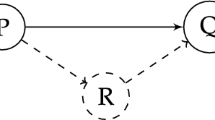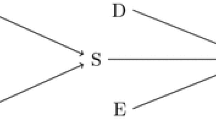Abstract
The paper uses a de-relativized (or objectified) variant of Woodward’s definition of direct type-level causation to develop an account of causal ceteris paribus (cp) laws. It argues that the relation between X and Y needs to satisfy three conditions in order to qualify as one of direct type-level causation, that satisfaction of these conditions guarantees the applicability of claims of direct type-level causation, that the context of applicability motivates referring to these conditions as cp conditions, and that claims of direct type-level causation qualify as laws if they are explanatorily deep. The account of causal cp laws defended by the paper derives from a de-relativized variant of Woodward’s definition of direct type-level causation but can be shown not to conflict with Woodward’s thesis that there is no such thing as a cp law.
Similar content being viewed by others
Notes
Boumans and Morgan (2001, p. 13) introduce the Latin expressions for (CP2) and (CP3). Following their lead, one may refer to (CP1) as a ceteris constantibus clause.
There is, of course, substantial disunity among philosophers of science over the question whether causal statements can be accepted as true if there can’t be any physically possible interventions for these statements. Woodward, however, is prepared to accept a causal statement as true as long as there is at least one (ideally or physically) possible intervention for that statement.
The problem with the Hausman test is that it relies on the notion of an unbiased instrumental variable (IV) estimator: on the notion of an unbiased estimator for a variable that is itself assumed to be uncorrelated with an error. Before conducting a Hausman test, one would in fact have to test the hypothesis of no correlation between an instrument and the error term. And the frustrating thing about such a test is that it is not available. Something that comes close to an econometric test of the correlation between an instrument and an error is only available in the case in which the equation into which the instrument is introduced is “over-identified”: in which this equation includes at least two instruments for the regressor that is correlated with the error. This test (usually referred to as the Sargan test) assumes that among the instruments is at least one valid instrument per regressor correlated with the error. It involves the estimation of the parameters and residuals of the equation in question as well as the regression of the residuals on the instruments. And it is supposed to be successful if the regression of the residuals on the instruments yields coefficient estimates that are insignificantly different from zero. But the problem with this test is that even a successful test doesn’t tell us which of the instrumental variables are valid instruments. It doesn’t tell us, that is, which of the instruments might be used to calculate an IV estimator for the Hausman test.
References
Boumans, M., & Morgan, M. S. (2001). Ceteris paribus conditions: Materiality and the application of economic theories. Journal of Economic Methodology, 8(1), 11–26.
Cartwright, N. (1983). How the laws of physics lie. Oxford: Clarendon.
Earman, J., & Roberts, J. (1999). Ceteris Paribus, there is no problem of provisos. Synthese, 118, 439–478.
Fodor, J. (1991). You can fool some of the people all the time, everything else being equal; hedged laws and psychological explanations. Mind, 100, 19–34.
Friedman, M., & Schwarz, A. J. (1963). A monetary history of the United States, 1867–1960. Princeton, NJ: PUP.
Hausman, D. M. (1992). The inexact and separate science of economics. Cambridge: CUP.
Hitchcock, C., & Woodward, J. (2003). Explanatory generalizations, part II: Plumbing explanatory depth. Nous, 37(2), 181–199.
King, R. G., & Plosser, C. I. (1984). Money, credit and prices in a real business cycle. American Economic Review, 74, 363–380.
Musgrave, A. (1981). “Unreal Assumptions” in economic theory: The F-Twist Untwisted. Kyklos, 34, 377–387.
Strevens, M. (2007). Review of Woodward, making things happen. Philosophy and Phenomenological Research, LXXIV(1), 233–249.
Woodward, J. (2002). There is no such thing as a ceteris paribus law. Erkenntnis, 57, 303–328.
Woodward, J. (2003). Making things happen: A causal theory of explanation. Oxford: OUP.
Woodward, J. (2008). Response to Strevens. Philosophy and Phenomenological Research, LXXVII(1), 193–212.
Woodward, J., & Hitchcock, C. (2003). Explanatory generalizations, part I: A counterfactual account. Nous, 37(1), 1–24.
Acknowledgments
Valuable and very helpful comments and suggestions by two anonymous referees are gratefully acknowledged.
Author information
Authors and Affiliations
Corresponding author
Rights and permissions
About this article
Cite this article
Henschen, T. Ceteris paribus conditions and the interventionist account of causality. Synthese 192, 3297–3311 (2015). https://doi.org/10.1007/s11229-015-0703-7
Received:
Accepted:
Published:
Issue Date:
DOI: https://doi.org/10.1007/s11229-015-0703-7




